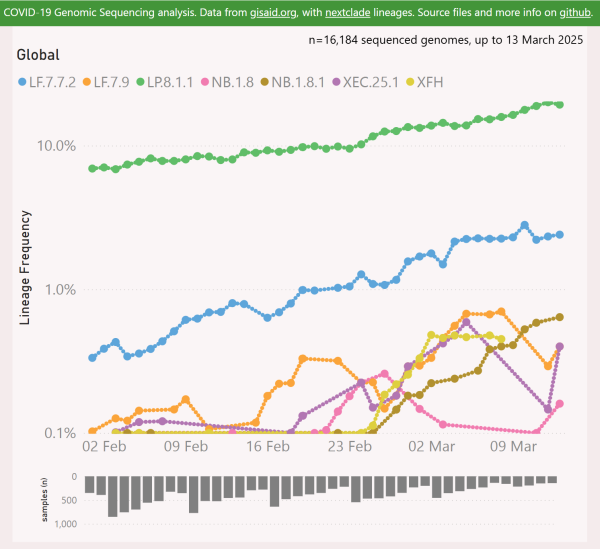With the LP.8.1.* variant on the way to dominance in most places, it is time to ponder which variant might drive the next wave.
The leading contenders at this point are LF.7.7.2, LF.7.9, NB.1.8.1, XEC.25.1 and XFH.
I show them here using a log scale, so you can compare their growth rates vs the most common LP.8.1.* sub-lineage: LP.8.1.1.
I show them here using a log scale, so you can compare their growth rates vs the incumbent LP.8.1.1 (19%).
#COVID19 #LF_7_7_2 #LF_7_9 #NB_1_8_1 #XEC #XFH
🧵
The leading contenders at this point are LF.7.7.2, LF.7.9, NB.1.8.1, XEC.25.1 and XFH.
I show them here using a log scale, so you can compare their growth rates vs the most common LP.8.1.* sub-lineage: LP.8.1.1.
I show them here using a log scale, so you can compare their growth rates vs the incumbent LP.8.1.1 (19%).
#COVID19 #LF_7_7_2 #LF_7_9 #NB_1_8_1 #XEC #XFH
🧵


Mike Honey •
LF.7.7.2 has been most successful in Canada (especially Quebec), rising to 12% frequency. The US has reported growth to 4%.
🧵
Mike Honey •
XDV.1 added the F456L mutation, then XDV.1.5 added G184S and K478I. NB.1 then added Spike mutations: T22N and F59S. Then NB.1.8 added the Spike Q493E mutation that characterised KP.3.1 FLuQE – an example of convergent evolution. Finally NB.1.8.1 added the A435S mutation.
NB.1.8.1 has mainly been reported from Hong Kong, rising to 50% frequency.
🧵
Hugs4friends ♾🇺🇦 🇵🇸😷 hat dies geteilt
Mike Honey •
LF.7.9 has been most successful in Ireland, rising to 50% frequency. The UK and France have reported growth to 5%.
🧵
Mike Honey •
XEC.25.1 has only been reported from Singapore, rising to 40% frequency. Prior to this sub-lineage, the XEC.* variant had not been dominant in Singapore.
🧵
Mike Honey •
XFH has been most successful in Singapore, rising to 7% frequency. The UK has reported growth to 6%.
🧵
Hugs4friends ♾🇺🇦 🇵🇸😷 hat dies geteilt
Mike Honey •
I will continue to monitor this topic.
🧵
Mike Honey •
Honourable mention to NB.1.8 (low growth so far).
🧵
Hugs4friends ♾🇺🇦 🇵🇸😷 hat dies geteilt